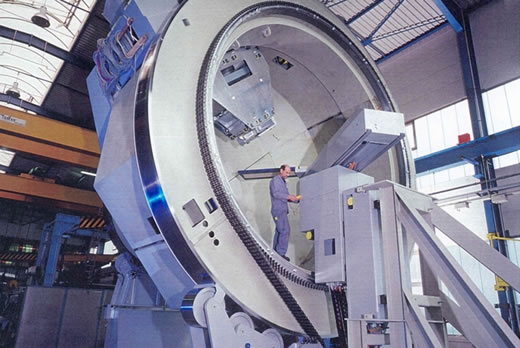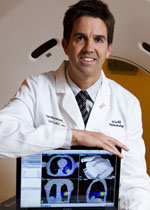In 2016, when the Georgia Proton Treatment Center* opens its doors on the corner of Peachtree and North Avenue, adjacent to Emory's midtown campus, it will be a dream come true for many, and for no one more than Tim Fox, director of medical physics in radiation oncology. With the addition of proton therapy, Emory's Winship Cancer Institute will be one of 10 centers nationwide offering patients every type of tumor-destroying radiation that exists.
Fox joined the faculty in 1994 and became chief of medical physics in 2003. The major part of his job in radiation oncology—and the work of the 15 PhD- and master's-level physicists and eight dosimetrists he currently oversees—involves planning and providing extremely precise radiation treatments. Before beginning radiation therapy, most patients have a CT scan and then wait several days while the oncology team creates a personalized plan to maximize tumor destruction while minimizing damage to healthy tissue.
That's what makes the medical physicist's job so challenging, says Fox. And it's also what makes adding proton therapy to Emory's arsenal so exciting. Currently, traditional therapy may involve technology combining intensity-modulated radiation therapy, which breaks large radiation treatment fields into hundreds of small pencil beams, with unique beam trajectories and orientations that "paint" different levels of dose into the tumor volume. Another tool is brachytherapy, which uses radioactive "seeds" that can be placed inside or alongside prostate, gynecologic, and other tumors, delivering small-dose, constant radiation from the inside out.
Each of these traditional therapies uses photons. Proton therapy gets its power because protons release a burst of energy when they reach the end of their path at the site of the tumor (known as the "Bragg peak"). Proton therapy enters the skin with very little dose and then gives up almost all its dose at one spot. It is particularly appropriate for highly sensitive areas like the brain, eye, or prostate. Think, for example, of a small child with a tumor behind the eye. Calibrated precisely, the protons pass through the optic tissue with very little dose, deliver their entire payload at the tumor site, and quickly fade away with no radiation left to harm the brain.
In addition to helping design therapy plans for patients, Fox is responsible for ensuring that the complex machinery involved in generating and delivering radiation is perfectly calibrated to deliver the correct radiation dose. Emory's radiation oncology section manages 12 linear accelerators in metro Atlanta. As opposed to the weaker rays needed for diagnostic medical imaging devices, the X-ray energy produced by accelerators is so high that each one must be surrounded by three feet of concrete with massive protective doors. These accelerators must be monitored every day, but that will seem simple compared with the calibration and quality assurance required for the highly complex proton therapy center equipment, which will operate 16 hours a day, six days a week.
Tim Fox |
A faculty member in both the medical school and at Georgia Tech, Fox has designed medical imaging software, and he teaches medical physics students at Tech and radiation oncology residents at Emory. He also has been known to share his love of math and physics with lay audiences, including most recently at TEDxPeachtree last month, where he gave a 10-minute talk on why math is oncology's new best friend.
Over the next three years, as Emory gears up for the proton center's opening, Fox will be seriously recruiting, with a plan to more than double his medical physicists team. There's a lot in play, but the former college baseball player is ready for what comes next.
*To be operated by Emory Healthcare, the new center is being built and will be owned by Advanced Particle Therapy, with equipment supplied by Varian Medical Systems.


